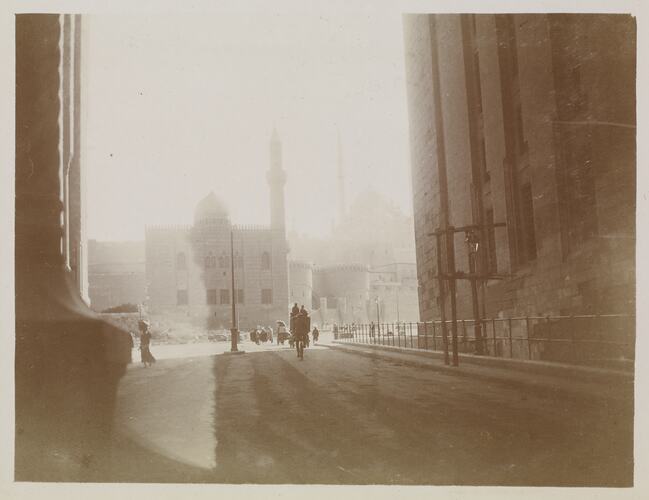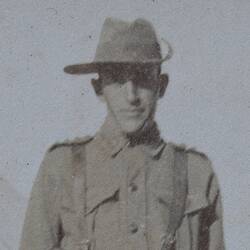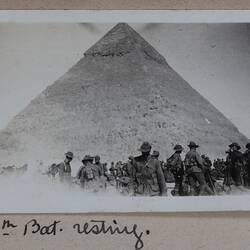Summary
One of 108 images in an album from World War I likely to have been taken by Captain Edward Albert McKenna. The album contains photographs of the 7th Battalion in Egypt.
Image of the Citadel, flanked by mosques. For 700 years Egypt was ruled from the hill on which the Citadel stands. The first building erected on this site was a bastion of Saladin in the 12th century. In the 13th century, the Mamluk Sultan, al-Nasir Muhammad, demolished several of the Ayyubid buildings to make way for his own building works. These were later demolished by Ottoman Sultan Muhammad 'Ali who redesigned the Citadel according to his own preference. Today the citadel still resembles that built by Muhammad 'Ali and the two mosques in the image are the Muhammad 'Ali Mosque and the al-Nasir Muhammad mosque. Nothing remains of the original building erected by Saladin aside from Bir Yusuf, the well that supplies the Citadel with water.
The album relates to the service of Captain Edward Albert McKenna. McKenna, born in Castlemaine, Victoria, was a 36-year-old department manager of soft goods when he enlisted on 17 August 1914. He lived at 5 St James Buildings, William Street, Melbourne, and had been married to Elizabeth ('Lillie') Mary McKenna since 1910. He embarked from Melbourne 19 October 1914 on the HMAT Hororata, and served in the 7th Battalion Australian Infantry.
He was killed in action in Gallipoli around 25-30 April 1915, aged 37. His kit bag was unusually full, even containing seven shirts, a pillow, six towels, a travelling rug, gumboots, and pyjamas and slippers. Also amongst his possessions was a camera, although no photographic prints or albums.
He was buried at 7 Lone Pine Cemetery, Gallipoli. His details appear on the honours roll on the web page of the Australian War Memorial.
Description of Content
Located in the near distance two very large mosques and a citadel are visible.The photograph has been taken from beneath an archway, therefore tall brick walls feature on both sides of the image in the foreground. In front of the buildings in the centre of the photograph, local Egyptian people can be seen going about their daily lives - walking around, leading donkeys with packs and riding on carriages pulled by donkeys. A singular Australian soldier is visible, riding a bicycle towards the citadel.
Physical Description
Black and white photographic print on paper with a white border.
More Information
-
Collection Names
Returned and Services League (RSL) Collection, Military Memorabilia Collection
-
Collecting Areas
-
Acquisition Information
Donation from Mr J. Willis, circa 1986
-
Acknowledgement
Mr. J. Willis
-
Place & Date Depicted
-
Photographer
Captain Edward A. McKenna - Australian Imperial Force (AIF), Cairo, Egypt, 1914-1915
-
Creator
-
Inscriptions
Hand written in ink on the support to the left of the photograph: 'Citadel / in / centre / in / the / distance' Hand written in ink on the support to the left of the photograph: 'Mosques / on / either / side' Hand written in pencil on the back of the photograph: 'Mosques on each side. Citadel in the centre / in the distance'
-
Classification
-
Category
-
Discipline
-
Type of item
-
Image Dimensions - Photograph
84 mm (Width), 108 mm (Height)
-
Image Dimensions - Photograph album page
174 mm (Width), 141 mm (Height)
Dimensions measurement is of the photograph album page.
-
References
National Archives of Australia: McKenna Edward Albert, barcode 1949283, series B2455/1. 'The Citadel,' Sacred Destinations, at: [Link 1] accessed: December 19, 2012
-
Keywords


